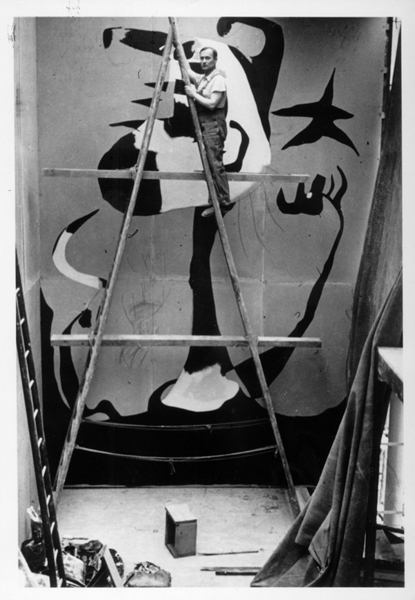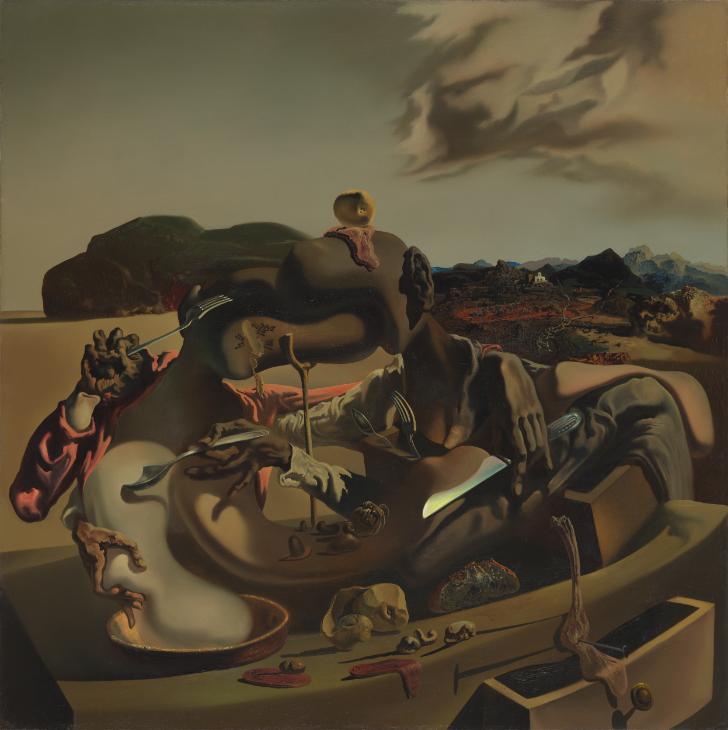Spanish War Art
Beginning of the war
Canibalismo de Otono, Salvador Dali, 1936. Italy
In 1936, when the Spanish civil war started, Dali and Gala migrated to Italy. Naturally, this theme is reflected in Dali´s artwork. His artistic expression shifts to record the historical situation with his apathetic and neutral position.
In this painting, we find a couple of people that form one single figure. They are devouring each other, and the scene is full of mutilations and grotesque viscera. The brushwork is exquisite, and the soft blending creates a warm and inviting atmosphere. The rendering of the light, presumably at sunrise or sunset, fills the scene with warm colors. The composition is fluid, melting, and the figures are decomposed and dissolved until one remains. They seem to enjoy it; they seem to be caught in their own sensual pleasure that both are more than happy to engage with. Most organic materials rot and decompose, which does not bother the couple.
Unlike Picasso, Dali thought the civil war was a natural occurrence, part of the circle of life. Where the strong philosophy and morals will come out as the winner, in other words, natural selection. He argued (in his poetical and complicated fashion) that the revolution helped to sort the damage that the traditional and religious beliefs were suffering, thus revealing a "burning death" that would revive the rotten treasures of the Spanish nation.
The calm and cold approach to another war seems depressing. Especially since WWI had already ended, but another was brewing in the Nation and Internationally. This painting does a great job of reflecting the surrealist reaction to war, considering it human nature and inevitable. Dali has embraced that as reality and voluntary surrender to the catastrophe. However, he seems to push it further and play with the eroticism and absurdism of the situation, even like surrendering to a lover.
When the Dictatorship of Franco was established, Dali returned to Spain and sympathized with the regime. He would then create artwork that had its roots in tradition and religion and a portrait of Hitler on several occasions.
When the International World Fair opened in Paris in 1937, Dali was missing from the event. However, two other works by his contemporaries/contraries were presented at the event.
The struggles

El segador, Joan Miro, 1937, Paris
In 1937, the Universal Exposition opened its doors in Paris. The Spanish Republican government had a Pabillion where they exposed several Spanish artists. In addition, it would tell the horrors of the Civil War that the Spanish were immersed in and were part of the fight against fascism from the Republican front.
The famous Guernica was a painting that Picasso created just for this exhibition.
El Guernica had better luck than some of their contemporary pieces; Since a significant amount of them disappeared mysteriously right after the fair.
This is the case of the Mural of Joan Miro titled "The Reaper." Unfortunately, only a couple of black-and-white photos are preserved.
The mural portrayed a reaper, wearing a Barretina (a Catalonian version of the Phrygian hat) and without legs. It was buried in the dirt, resembling a tree. One hand with the scythe and the other reaching for a star. In contrast to Dali, Miro's shapes are thin, sharp, and crooked. The mural complimented El Guernica since it was exposed at the same pavilion.
Unfortunately, we cannot discuss the color composition since that data was lost in time. But the design seems to reflect the struggle of the republican government to fight against fascism. The Reaper can be seen as something emerging from the dirt, like a growing organism, at the same time that can be read as being impaired as a consequence of the lost battles. Nevertheless, it holds the weapon high and is ready to fight. It is not giving up like we see in Dali's subjects.
The Reaper reflects a generation that wanted to win its liberty. Much like Alberto Sanchez, who I discuss below, the mural was clear with its theme and politics.
The Promise of Peace
El pueblo Espanol tine un camino que conduce a un estrella, Alberto Sanchez, 1937, Spain
Alberto Sanchez was another artist the Spanish Republican government asked to do a piece for the International Expo in Paris. His Piece, " The Spanish population has a path that leads to a star," is indudablely tied to socialism. This piece would stand proudly at the entrance of the Pavilion, welcoming the visitors.
Alberto was known for his tendency to approach surrealism from a realist point of view. So there is a high chance that the sculpture was shaped after primary forms. There are a couple of symbols that are easy to spot. First, the apparent red star on top represents Socialism, but a little bit underneath it, we can find a bird shape, probably a dove, since they symbolize peace.
The obelisk shape that supports these two things is also very organic. Some like to see a struggling organism raising a star in the sky despite all the adversities. Others want to see it as a plant growing directly from the floor. Technically, the curvilinear and helicoidal structure significantly affects aesthetics and beauty.
Like Miro and Dali, the lines are very fluid and very organic.
From my personal reading, I can see how the craters around the structure might represent the impacts and damage caused by the bombs during the war that was taking place. I like the poetry of comparing them to moon craters, where the damage is irreversible, but the moon stands strong nevertheless.
The difference with Dali is that this organism is reaching up, succeeding, and bringing peace. Glorious aftermath of the Fight, the Miro's Reaper was battling with. A prayer to end the war that Dali was already surrendered to and Miro was still fighting for.
References:
Tate. “'Autumnal Cannibalism,' Salvador Dalí, 1936.” Tate, 1 Jan. 1970, https://www.tate.org.uk/art/artworks/dali-autumnal-cannibalism-t01978.
Canibalismo Del Otoño, https://www.artehistoria.com/es/obra/canibalismo-del-oto%C3%B1o.
“ʻEl Segadorʼ, De Joan Miró, Vuelve Al Pabellón De La República.” Actualitat, https://web.ub.edu/es/web/actualitat/w/joan-miros-ithe-reaperi-is-back-in-pavello-de-la-republica.
“El Segador (Pintura).” Wikipedia, Wikimedia Foundation, 7 Feb. 2023, https://es.wikipedia.org/wiki/El_segador_(pintura).
“El Pueblo Español Tiene Un Camino Que Conduce a Una Estrella.” Wikipedia, Wikimedia Foundation, 16 Nov. 2022, https://es.wikipedia.org/wiki/El_pueblo_espa%C3%B1ol_tiene_un_camino_que_conduce_a_una_estrella.
Pabellón De La República Española, 1937 - Museo Nacional Centro De ... https://www.museoreinasofia.es/sites/default/files/salas/informacion/206_7_pabellon_de_la_republica_espanyola_1937.pdf.


_(4696748998).jpg/440px-%22El_pueblo_espa%C3%B1ol...%22(Museo_Nacional_Centro_de_Arte_Reina_Sof%C3%ADa%2C_Madrid)_(4696748998).jpg)
Comments
Post a Comment